Key takeaways:
- Book swaps foster community and personal connections by allowing participants to share their reading experiences and discover new genres.
- Clear communication about expectations and book conditions is essential for successful swaps to prevent disappointment.
- Adding personal touches, such as notes or unique wrapping, can enhance the swapping experience and create memorable connections.
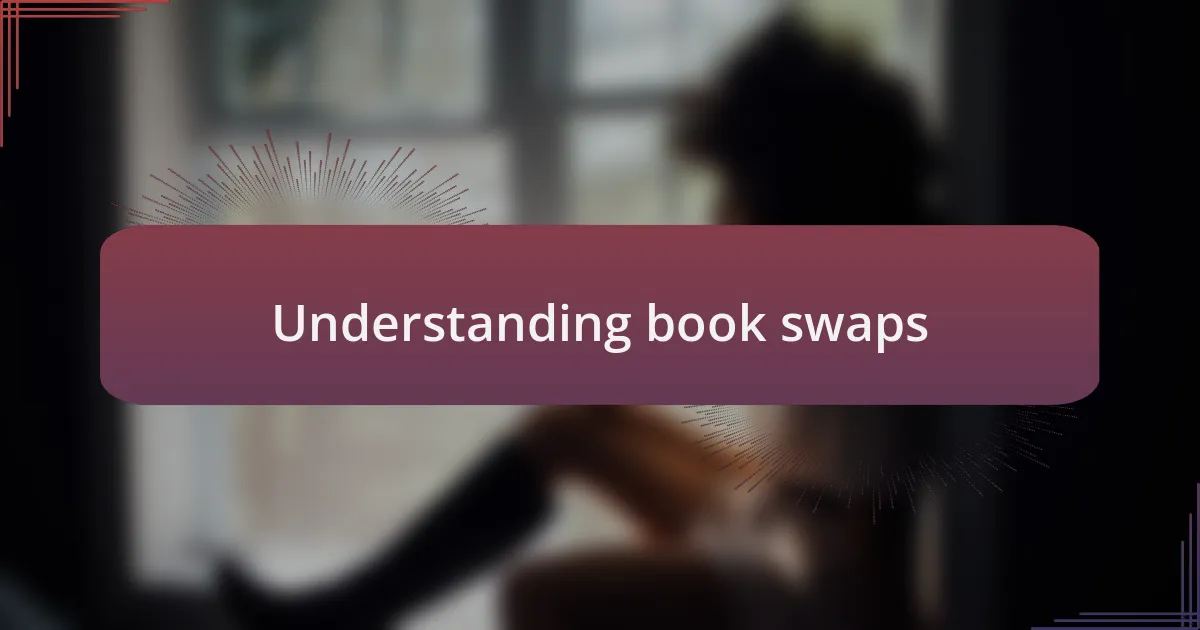
Understanding book swaps
Book swaps are a fascinating way to exchange literature without the financial burden of buying new books. I remember my first swap event; the excitement buzzed in the air as fellow book lovers gathered with their beloved tomes. Isn’t it refreshing to think about how many lives a single book can touch, just by passing it on to someone else?
Understanding book swaps also means recognizing the community aspect they create. When I swapped my copy of a beloved novel, I didn’t just give away a book; I shared a piece of my experience. Have you ever felt the thrill of connecting with someone over a shared story? That bond makes the swap not just transactional but deeply personal.
In essence, book swaps can open doors to discovering new genres and authors you might not typically consider. I often found hidden gems that led to unexpected favorites. What about you? Have you ever picked up a book you wouldn’t have chosen on your own and ended up loving it? That’s the magic of book swaps.
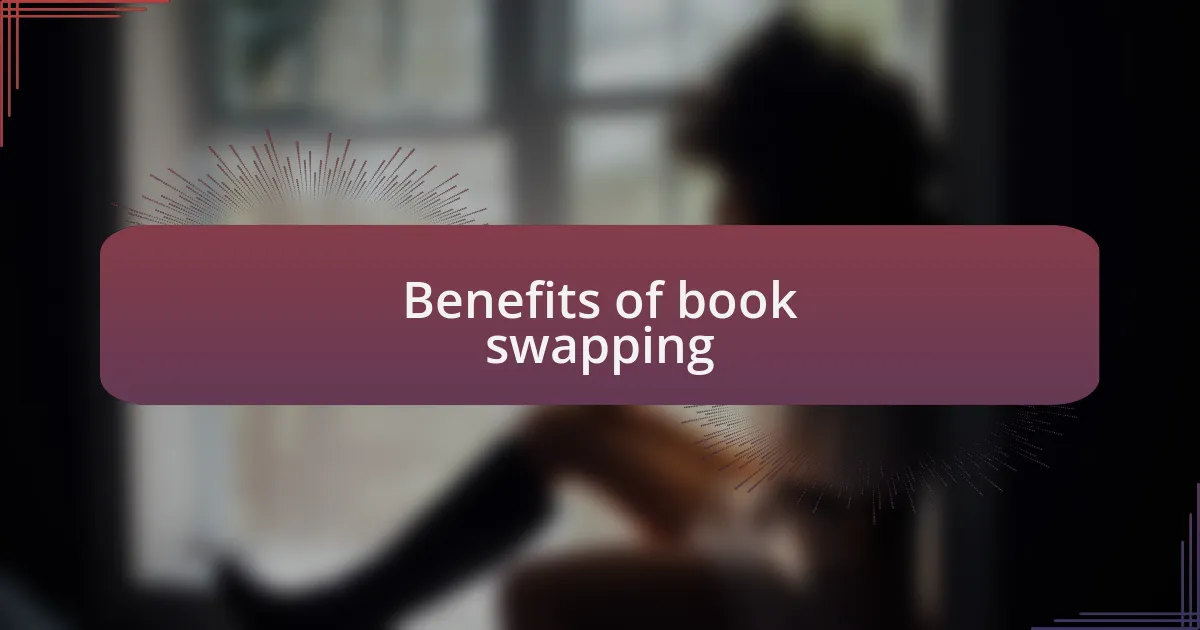
Benefits of book swapping
Engaging in book swapping not only saves money but also fosters a sense of community among readers. The first time I participated in a swap, I was amazed at how much joy came from simply sharing books with strangers. Have you ever felt that rush when you hand over a book and see the recipient’s eyes light up? It’s a small but powerful connection.
Another benefit is the chance to explore diverse genres and voices, which often leads to personal growth. I recall swapping a historical fiction novel for a contemporary debut, which, honestly, I would never have picked up on my own. It turned out to be a transformative read. Doesn’t it feel satisfying to step outside your comfort zone and discover something wonderful?
Lastly, the act of giving away books can be incredibly liberating. I’ve experienced that bittersweet moment when I part with a beloved title, but it’s outweighed by the excitement of knowing it’ll bring joy to someone else. Isn’t it heartwarming to think of the adventures your book will embark upon next? Book swapping is about letting go and receiving—and, in that exchange, we grow.
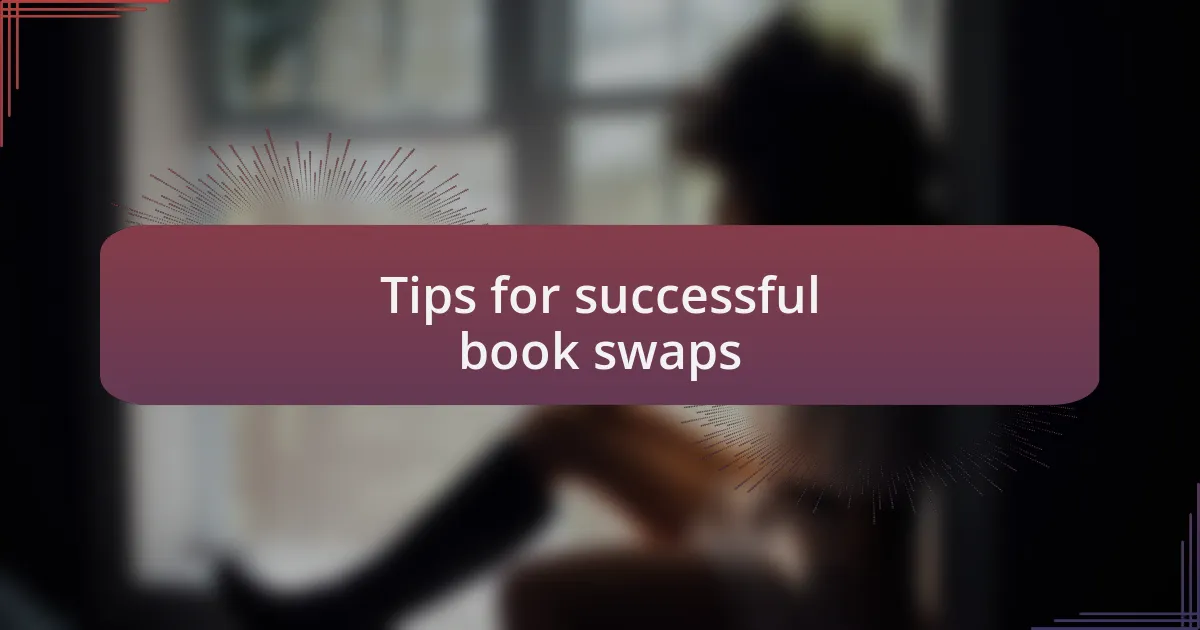
Tips for successful book swaps
When it comes to successful book swaps, clear communication is essential. I always make it a point to discuss what kinds of books I’m looking for, as well as the condition of the ones I’m offering. Have you ever exchanged a book, only to find out it wasn’t quite what you expected? Being upfront about preferences can save both parties from disappointment and ensure a more rewarding experience.
Another tip I’ve found invaluable is to stay organized. I keep a list of books I want to swap along with their details—genre, condition, and personal rating. This way, when someone expresses interest, I can quickly assess if it’s a good fit. Isn’t it a hassle to clutter your mind with all those titles? A simple list makes the process smoother and way more enjoyable.
Lastly, don’t underestimate the power of a little creativity in making your swaps memorable. I once wrapped a book in colorful paper and added a handwritten note sharing why I loved it. The recipient’s surprised smile revealed that thoughtful touch truly made a difference. Have you ever received a gift that felt extra special because of the personal touch? It’s those small gestures that can elevate the experience and foster a deeper connection between swappers.
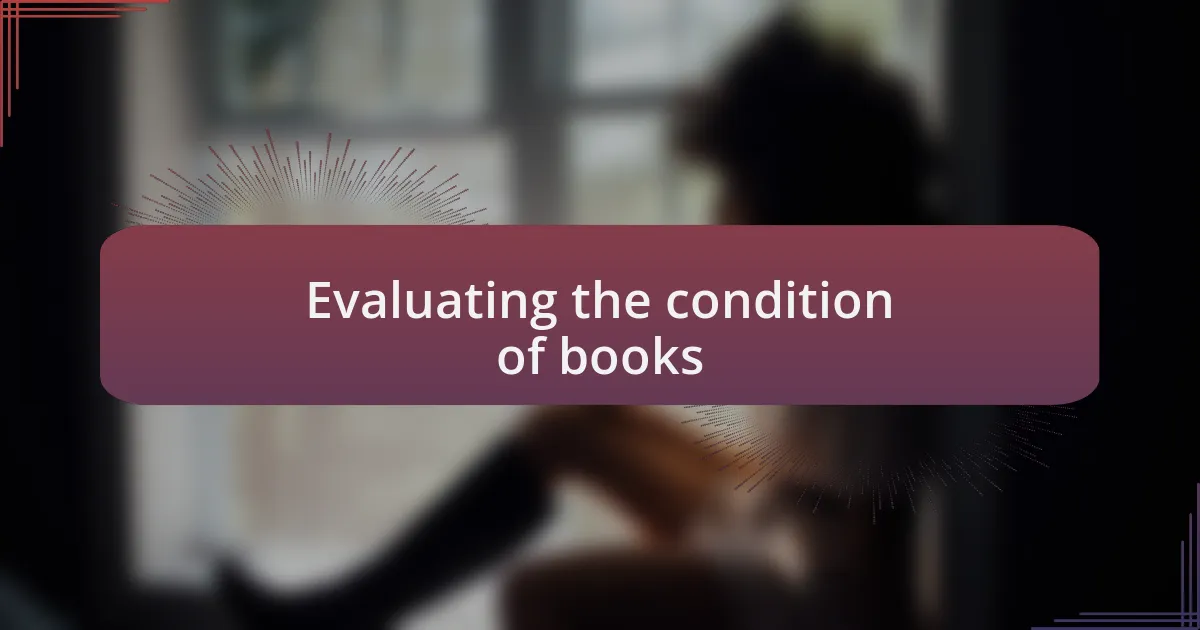
Evaluating the condition of books
When evaluating the condition of books for swaps, I always consider the visible wear and tear. I remember a time when I received a book that had its spine cracked and pages dog-eared; I felt a bit cheated. Have you ever opened a book expecting it to be pristine, only to find it’s been well-loved? It’s crucial to examine the cover, binding, and any marks that might indicate how much the book has been read.
In my experience, understanding what constitutes “acceptable” conditions varies between swappers. For me, a book with minor scuffs is fine, but I’ve learned some swappers are more particular. I often ask questions about specific details, like whether there are any handwritten notes. This saves me from surprises and ensures mutual satisfaction. What about you? Have you ever found yourself in a swap where the book didn’t meet your standards, and how did you handle it?
Lastly, I pay attention to the seller’s description and pictures. A well-lit, clear image can reveal so much about a book’s condition. I once passed on a swap because the provided image showed a torn cover that I hadn’t noticed at first. It’s a simple step, but it can prevent future disappointments. When you think you’ve found the perfect read, isn’t it worth taking a moment to scrutinize the details?
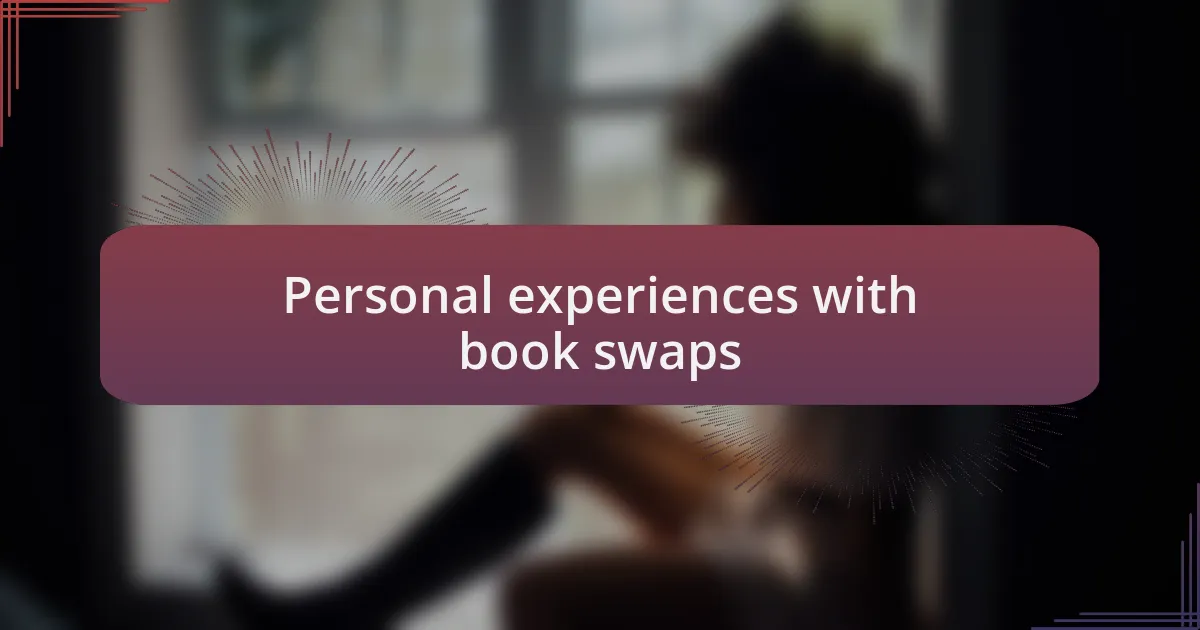
Personal experiences with book swaps
When I first participated in a book swap, I was filled with excitement. I remember trading a beloved fantasy novel for a classic I’d always wanted to read. Unfortunately, the book I received had more annotations than I anticipated, which made it hard for me to immerse myself in the story. Have you ever felt like the original reader kept interrupting your journey? That experience taught me the importance of clear communication about expectations for notes or markings.
In another swap, I traded a rare hardcover edition for a contemporary title. The thrill came from not just receiving a new book but also from learning about the other person’s reading preferences. I can still recall the joy in exchanging stories about why we chose those specific titles. It was a reminder that book swaps are as much about the experience and connection as they are about the books themselves. Have you ever bonded over a book with someone you just met? Those unexpected conversations can turn a simple swap into a memorable moment.
I also had a fascinating encounter with a swapper who sent me a book wrapped in beautiful paper, complete with a personal note. That extra touch made the swap feel special. It reinforced how personalizing the experience can elevate the simple act of trading books into something more meaningful. Have you ever considered adding a personal note to your swaps? It’s a small gesture, but it might create lasting connections within the book community.
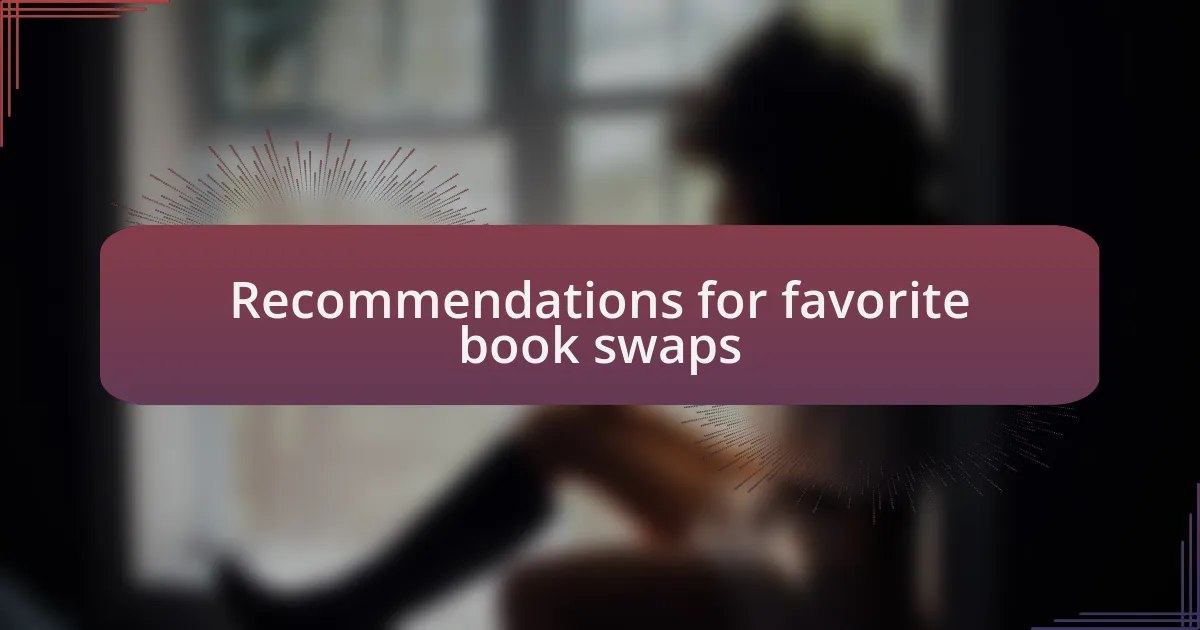
Recommendations for favorite book swaps
When considering book swaps, I’ve found that setting clear expectations is key. For instance, I once exchanged a well-loved mystery novel, only to discover later that the other swapper had a different definition of “like new.” This misalignment led to disappointment on both sides. Have you ever traded something valuable only to realize it wasn’t what you expected? It’s a good reminder to communicate specifics about the book’s condition before finalizing the trade.
During another book swap, a fellow participant surprised me with a genre that I typically wouldn’t pick up: a historical fiction piece. I remember the excitement of flipping through its pages and immersing myself in a time period I hadn’t previously explored. That experience taught me the joy of stepping outside my comfort zone. How often do you let someone else’s enthusiasm lead you to a new favorite? Sometimes, a recommendation from a fellow reader can introduce you to worlds beyond your usual preferences.
One of my fondest book swap moments was when I received a book that was intricately tied to the swappers’ personal journey. The accompanying note shared their connection to the story, which added a layer of depth to my reading experience. It made me realize how powerful sharing stories can be—both between readers and the books we exchange. Have you ever been affected by the story behind a book? These personal touches transform a simple swap into an enriching dialogue, reminding us that every book comes with its own narrative.